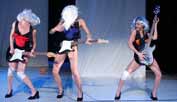| |
|
|
|
| |
|
Coreographer: Pal Frenak
Music: Fabrice Planquette
Light: Janos Marton
Sound: Attila Hajas
Stage: Laszlo Ferenczi
Cast: Viktoria Kolozsi, Lisa Kostur, Kata Juhasz, Stephanie Batten-Bland, Attila Gergely
|
|
| |
|
|
|
| |
|
For Pal Frenak, born in Hungary to deaf-mute parents, gesture preceded language. After seven years at boarding school, where his interest in theatre and cinema enabled him to overcome a difficult atmosphere, he received training in classical and modern dance at the Endre Jessinski Academy in Budapest. He moved to Paris in 1988.
The folklore and classical traditions I learned in Hungary did not give me the tools I needed and sought. In France, new horizons opened up to me. I was introduced to new concepts related to architecture, the visual arts, philosophy, and the cinema. These disciplines have deeply influenced my work.
On several occasions he has collaborated and improvised with composers of contemporary music, including François Donato and Gyorgy Kurtag. In 1993, he created his first significant choreography, Les Palets which is a look at a hidden childhood.
A solitary worker, Pal Frenak finds inspiration in travel. In 1998, he was awarded a fellowship from the Kujoyama Villa in Kyoto as part of the Ministry for Foreign Affairs’ residencies for artist programsmes. While there, he elected to study everyday gesture in Japan and to explore on his own a universe which to him was foreign. He met with Kazuo Ohno and was touched by his integrity. He scoured the country in search of water sources (springs, traditional baths…), and he observed the reservation and simplicity of gesture among the people.
Upon his return, Frenak led his company into a period of creative production whilst based in France and Hungary where it received support from the Trafó Haz, Budapest’s contemporary arts theatre.
|
|
| |
|
|
|
| |
|
About the play:
Women on stage, in both real and unreal worlds.
On stage the rituals of Csajok, which are displayed through the movements of the dance, lead us into hitherto unseen regions of unconsciousness. The image and understanding of ourselves is built from archetypal foundations inherited from the species as well as those that society imposes on us. This is an understanding that we are constantly at odds with, something we constantly fight in our unconscious life. Idealized, projected images, visions and dreams are the elements that, either real or imagined, grow inside ourselves and very often the lines between them are blurred.
Csajok attempts to illustrate this process; it attempts to give form to the process whereby dreams can become clearer, made more intense or even become more confused. Whatever the outcome the piece aims to show that dreams, like cream, always rise to the surface owing to their essentially lawless and individual nature.
Csajok or the Credo Hysterica is a sunk and forgotten world, an ethereal system that continually rebuilds and reinvents itself and leads us to modern life. The piece is played out in a setting where the invisible is given substance and where physical rules have disappeared, the Credo is an unknowable space, complete with its own traditions, and its desire for new rituals.
|
|
| |
|
|
|




